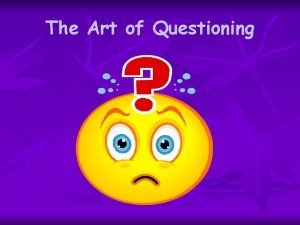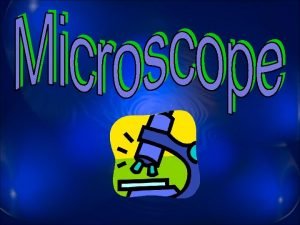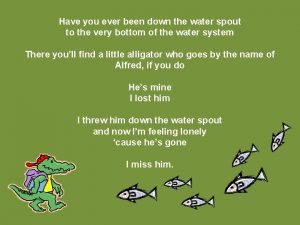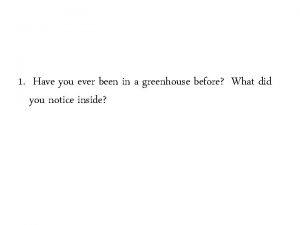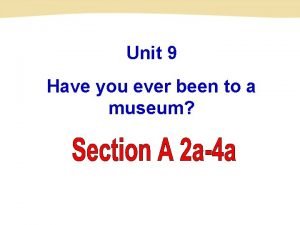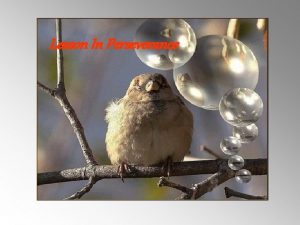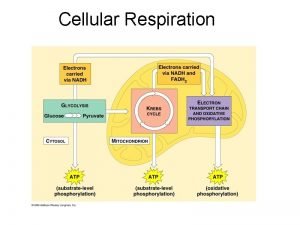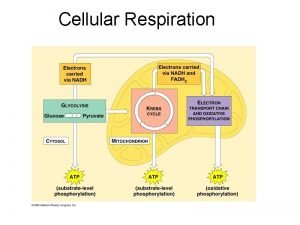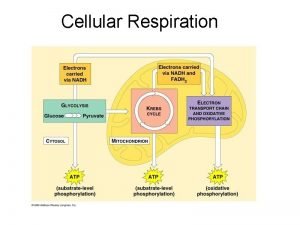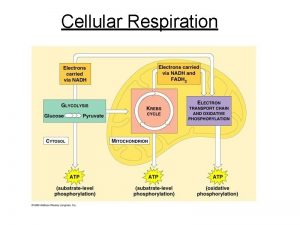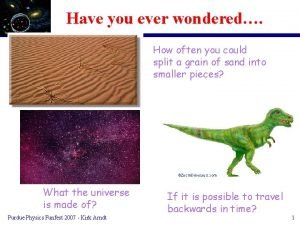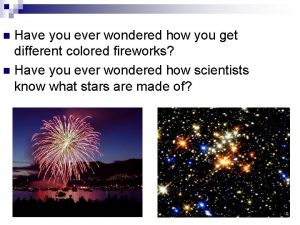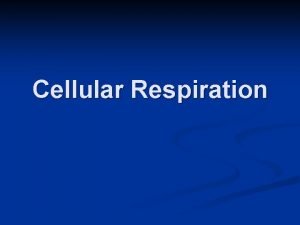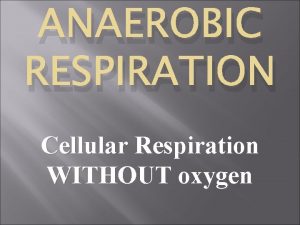Cellular Respiration Cellular Respiration Have you ever wondered




















- Slides: 20

Cellular Respiration

Cellular Respiration Have you ever wondered why exactly you need to breathe? What happens when you stop breathing?

Cellular respiration is the set of the metabolic reactions and processes that take place in the cells of organisms to convert biochemical energy from nutrients into adenosine triphosphate (ATP), and then release waste products.

C 6 H 12 O 6 + 6 O 2 -->6 CO 2 + 6 H 2 O + 36 ATP

Respiration occurs in the presence of oxgen - AEROBIC Without oxygen, another path is taken . . this path is called fermentation, or anaerobic respiration

There are three stages 1. Glycolysis 2. Kreb's Cycle (Citric Acid Cycle) 3. Electron Transport Chain

GLYCOLYSIS can occur without oxygen GLYCOLYSIS = "glyco - lysis " is the splitting of a 6 carbon glucose into two pyruvates, each having 3 carbons net yield of 2 ATP per glucose molecule net yield of 2 NADH per glucose molecule

2. Citric Acid or Krebs Cycle It is not necessary to know the individual steps a) occurs in the mitochondria b) an aerobic process; will proceed only in the presence of O 2

net yield of 2 ATP net yield of 6 NADH and 2 FADH 2 --> sent to ETC e) in this stage of cellular respiration, the oxidation of glucose to CO 2 is completed. (this is why we exhale carbon dioxide)

3. Electron Transport System: a) consists of a series of enzymes on the inner mitochondrial membrane b) electrons are released from NADH and from FADH 2 and as they are passed along the series of enzymes, they give up energy which is used to fuel a process called chemiosmosis which drives ATP synthesis

c) net yield of 32 or 34 ATP per glucose molecule d) 6 H 2 O are formed when the electrons unite with O 2* at the end of electron transport chain. * Note: This is the function of oxygen in living organisms! Without oxygen to serve as the final electron acceptor, the process shuts down.

Does this picture look familiar? You've seen this before in photosynthesis. Animation of the ETC Mc. Graw Hill Animation

Fermentation This happens when the Krebs cycle cannot occur due to lack of oxygen Byproducts of fermentation include lactic acid and alcohol Lactic Acid in muscle cells can cause muscle cramps.

Fermentation is used in making food products and alcohol products.

What are the 3 stages of cellular respiration? 1. 2. 3.

Food for thought 1. What is the purpose of cellular respiration? 2. Where does cellular respiration occur within the cell? 3. What is the waste product of cellular respiration? Would you go to an oxygen bar?

4. Compare Photosynthesis to Respiration a. Where does each occur? b. What are the products of each? c. What compounds are needed to start the processes? d. What is the function of the electron transport chain in each process e. Describe the role of ATPase in both processes.

Self Test 1. In order to produce energy, cells start with glycolysis. If oxygen is NOT present after glycolysis, what process occurs next? a) Electron Transport Chain b) Krebs Cycle c) Fermentation 2. If oxygen IS present after glycolysis, what process occurs next? a) Electron Transport Chain b) Krebs Cycle c)Fermentation 3. A process that does NOT require oxygen is known as what? a) Aerobic b) Anaerobic 4. In glycolysis, glucose is broken into 2 molecules of _________ acid 5. Where does the Kreb's cycle occur? _________ 6. What gas is a waste product produced in the Krebs cycle? ____

7. What enzyme is used in the electron transport chain to create ATP? a. citric acid b. pyruvate c. ATPase 8. Where does glycolyis occur? a. cytoplasm b. mitochondria c. chloroplast 9. Which process produces the largest amount of ATP? a. fermentation b. Krebs Cycle c. ETC 10. The oxygen required by cellular respiration is reduced and becomes part of which molecule? a. ATP b. CO 2 c. H 20

The Mystery of the Seven Deaths Case Study: http: //sciencecases. lib. buffalo. edu/cs/files/cellular_respiration. pdf In this case study, students learn about the function of cellular respiration and the electron transport chain and what happens when that function is impaired. Students play the role of medical examiner as they analyze the autopsy results to determine the cause of the mysterious deaths of these seven victims. ● Explain the overall purpose of cellular respiration. ● Describe the intermediate metabolites of cellular respiration. ● Explain the function and importance of the electron transport chain. ● Describe the role of oxygen in cellular respiration
 Have you ever wondered
Have you ever wondered The art of questioning
The art of questioning Have you ever wondered why some people
Have you ever wondered why some people People have wondered for centuries
People have wondered for centuries Ever ancient ever new
Ever ancient ever new Clarified it
Clarified it Ever ancient ever new
Ever ancient ever new Ever tried ever failed no matter
Ever tried ever failed no matter Have you ever done anything dangerous
Have you ever done anything dangerous Did you know
Did you know Jackie was filled with mortification
Jackie was filled with mortification Folkways
Folkways Have you ever climbed a mountain?
Have you ever climbed a mountain? Have you ever been down the water spout
Have you ever been down the water spout Have you ever ridden a camel?
Have you ever ridden a camel? Have you ever climbed a mountain
Have you ever climbed a mountain Have you ever been to britain
Have you ever been to britain Have you ever been to disneyland
Have you ever been to disneyland Have you ever watched people
Have you ever watched people What is a stanza in poetry
What is a stanza in poetry Have you ever been to disneyland
Have you ever been to disneyland

